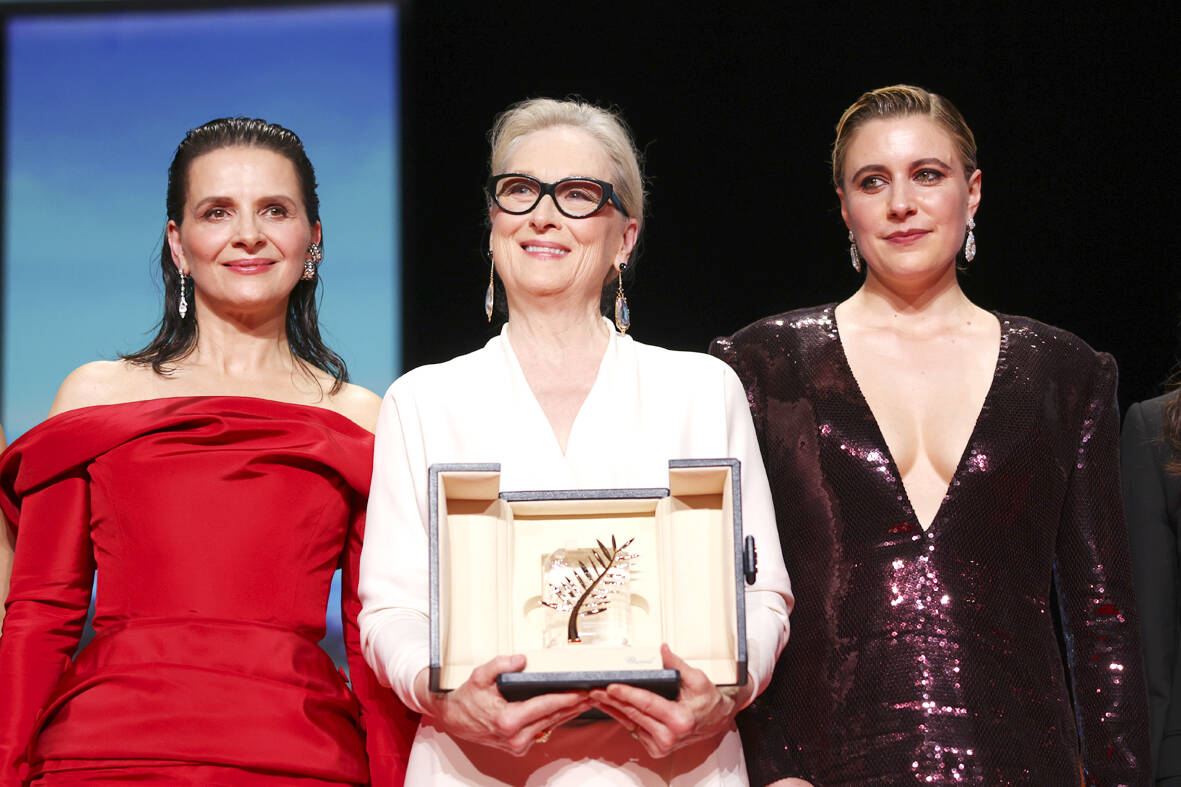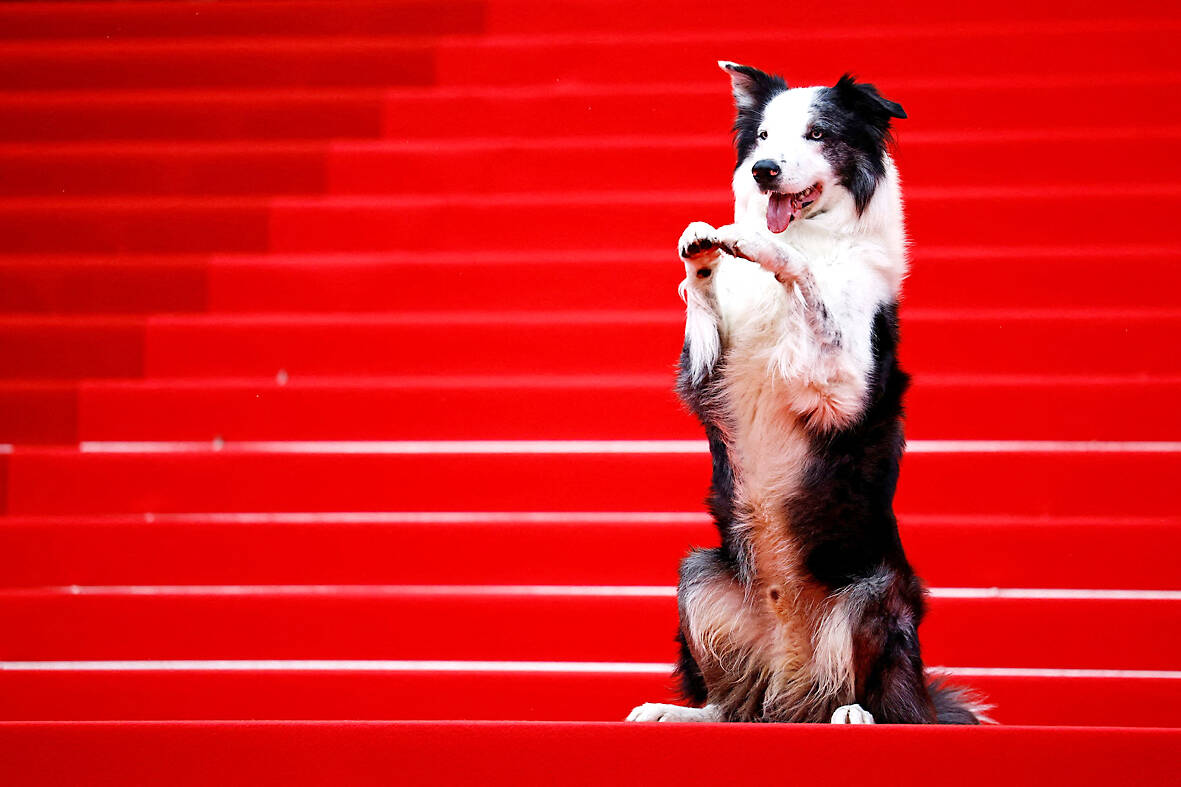The Cannes Film Festival is hallowed ground in cinema but understanding its unique landscape can be confounding.
The Cote d’Azur festival, which kicked off Tuesday, is a 10-day ballet of spectacle and film where even the photographers wear tuxedos, standing ovations are timed with stopwatches and movies tend to be referred to by the names of their directors — “the Almodovar,” “the Malick,” “the Coppola.”
From the outside, it can seem mad. From the inside, it can be hardly less disorienting. But grasping some of Cannes’ quirks and traditions can help you understand just what is unspooling in the south of France and what, exactly, a Palm Dog is.

Photo: AP
WHY DOES CANNES MATTER?
The short answer is that Cannes is the largest and arguably most significant film festival, and few care more deeply about the art of cinema than the French. This is where cinema was born and it’s where it’s most closely guarded. It’s not a coincidence that to enter the Palais des Festivals, the central hub, you must climb 24 red-carpeted steps, as if you’re ascending into some movie nirvana.
Cannes is also singularly global, attracting filmmakers, producers and journalists from around the world. It’s a little like an Olympics for film; countries set up their own tents in an international village. Because Cannes is also the largest film market in the world, many who come here are trying to sell their movies or looking to buy up rights. Deal-making, though not quite the frenzy it once was, happens in hotel rooms along the Croisette, aboard yachts docked in the harbor and, yes, on Zoom calls.

Photo: Reuters
But aside from being a beacon to filmmakers and executives, Cannes is a draw for its shimmering French Riviera glamour. Since the days of stars like Grace Kelly and Brigitte Bardot, Cannes has been renown as a sun-kissed center stage for fashion.
HOW OLD IS CANNES?
Originally called the International Film Festival, Cannes was born in the lead-up to World War II. Venice had launched the first major film festival in 1932, but in 1938, fascist influence on Venice was pervasive. The French government in 1939 chose the tourist destination of Cannes as the place for a new festival — though because of the war, the first edition wasn’t held until 1946. This year’s festival is the 77th edition.
WHAT IS IT LIKE ON THE GROUND?
The hive of activity is the Palais, a massive complex by the sea full of cinemas with names like Bunuel, Bazin and, the granddaddy, the Grand Theater Lumiere. This is where the red carpet runs in Cannes, nightly hosting two or three world premieres beneath a glass canopy flanked by rows of photographers. Festival cars ferry stars and directors who are ushered down the carpet and up the steps. Unlike most movie premieres, there are no reporters on the carpet.
Filmmakers and casts instead face questions from the media the day after their premieres, at a press conference preceded by a photo call. The press conferences can be atypically newsy, too; after Danish director Lars von Trier declared “I am a Nazi” at a Cannes press conference in 2011, he was named “persona non grata” by the festival for years.
Interpreters translate live for headphone-wearing reporters. Inside the Palais, bleary-eyed attendees are treated to gratis espresso.
Down the Croisette, the oceanside, palm tree-lined promenade of Cannes, there are regal old hotels like the Carlton and the Martinez from where festival attendees flow in and out, interviews might be happening on balconies as autograph-seeking fans gather outside in throngs. After-parties are typically held in clubs across the Croisette, by the beach.
WHO ATTENDS?
Unlike public festivals like Toronto or SXSW, Cannes is industry-only and largely out of reach for most moviegoers. That doesn’t stop the desperate, tuxedo-clad ticket seekers who hold signs outside the Palais on the chance someone has an extra, or the photo-takers who stand on small ladders near the red carpet.
Cannes is rigorously hierarchical, with a system of color-coded badges regulating access. If you hear about a film being booed at Cannes — even Martin Scorsese’s Taxi Driver was famously jeered before winning the Palme d’Or — it’s usually at a press screening.
The premieres, largely attended by industry professionals, are where the prolonged standing ovations take place. But this, like many things at Cannes, is a bit of stagecraft to boost the mythology. After the credits role, a cameraman rushes in, with his footage fed live to the screen. He goes down the aisles, giving the audience a chance to applaud for the director and each star. No one is just cheering for a dark movie screen.
WHAT DOES ‘IN COMPETITION’ MEAN?
Cannes hierarchy is in the lineup, too. Attention focuses most on the films “in competition:” usually around 20 movies competing for the Palme d’Or, the festival’s top award. Past winners include Apocalypse Now, Pulp Fiction and Parasite. Last year, it went to Justine Triet’s Anatomy of a Fall. Winners are chosen by a jury of nine that changes every year. This year’s is presided over by Greta Gerwig.
Competition is only one section, though. Many high-profile films might play out of competition, as Furiosa: A Mad Max Saga is this year. Un Certain Regard gathers a lineup of original or daring films. First and second films play in the sidebar Critics’ Week. There are also midnight selections and the recently launched Premiere sidebar, which also takes some overflow for films that didn’t fit into competition. Restorations and documentaries play in Cannes Classics.
And down the Croisette, separate from the official selection, is the Directors’ Fortnight or the Quinzaine, a parallel showcase launched in 1969 by a group of French filmmakers after the 1968 Cannes was canceled.
BUT WHAT ABOUT THE PALM DOG?
There are many other prizes, too, even an unofficial one created by journalists called the Palm Dog (sadly, not the Palme D’Og), for the best canine in Cannes. Last year, that honor went to Messi, the Anatomy of a Fall pooch.
Created in 2001, the annual award and its spinoff categories is decided by a jury of reporters. Past winners have included Uggie from The Artist (2011) and Sayuri, who played the heroic pit bull in Once Upon A Time ... In Hollywood (2019).
As for the reigning champ, Messi captivated the carpet on opening day this year, in town again as a correspawndent of sorts for French television.

The Democratic Progressive Party (DPP), Chinese Nationalist Party (KMT), and the country’s other political groups dare not offend religious groups, says Chen Lih-ming (陳立民), founder of the Taiwan Anti-Religion Alliance (台灣反宗教者聯盟). “It’s the same in other democracies, of course, but because political struggles in Taiwan are extraordinarily fierce, you’ll see candidates visiting several temples each day ahead of elections. That adds impetus to religion here,” says the retired college lecturer. In Japan’s most recent election, the Liberal Democratic Party lost many votes because of its ties to the Unification Church (“the Moonies”). Chen contrasts the progress made by anti-religion movements in

Taiwan doesn’t have a lot of railways, but its network has plenty of history. The government-owned entity that last year became the Taiwan Railway Corp (TRC) has been operating trains since 1891. During the 1895-1945 period of Japanese rule, the colonial government made huge investments in rail infrastructure. The northern port city of Keelung was connected to Kaohsiung in the south. New lines appeared in Pingtung, Yilan and the Hualien-Taitung region. Railway enthusiasts exploring Taiwan will find plenty to amuse themselves. Taipei will soon gain its second rail-themed museum. Elsewhere there’s a number of endearing branch lines and rolling-stock collections, some

Last week the State Department made several small changes to its Web information on Taiwan. First, it removed a statement saying that the US “does not support Taiwan independence.” The current statement now reads: “We oppose any unilateral changes to the status quo from either side. We expect cross-strait differences to be resolved by peaceful means, free from coercion, in a manner acceptable to the people on both sides of the Strait.” In 2022 the administration of Joe Biden also removed that verbiage, but after a month of pressure from the People’s Republic of China (PRC), reinstated it. The American

This was not supposed to be an election year. The local media is billing it as the “2025 great recall era” (2025大罷免時代) or the “2025 great recall wave” (2025大罷免潮), with many now just shortening it to “great recall.” As of this writing the number of campaigns that have submitted the requisite one percent of eligible voters signatures in legislative districts is 51 — 35 targeting Chinese Nationalist Party (KMT) caucus lawmakers and 16 targeting Democratic Progressive Party (DPP) lawmakers. The pan-green side has more as they started earlier. Many recall campaigns are billing themselves as “Winter Bluebirds” after the “Bluebird Action”